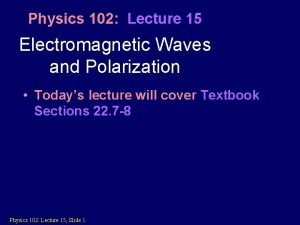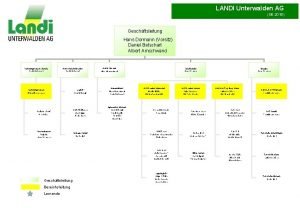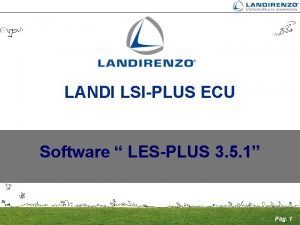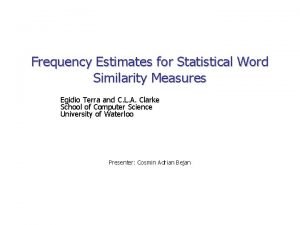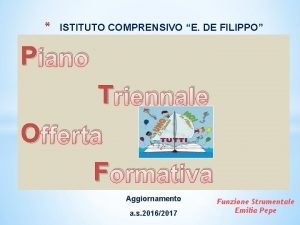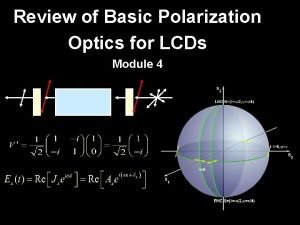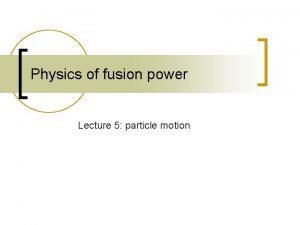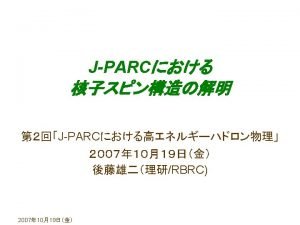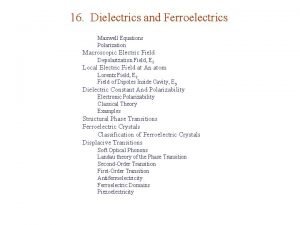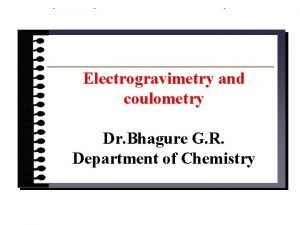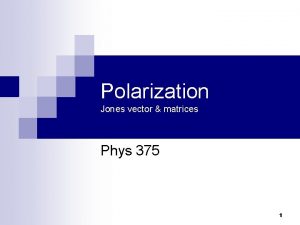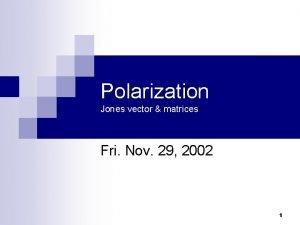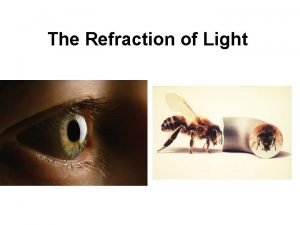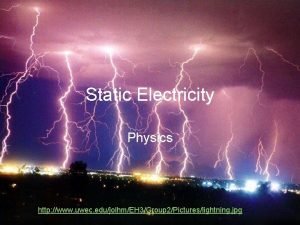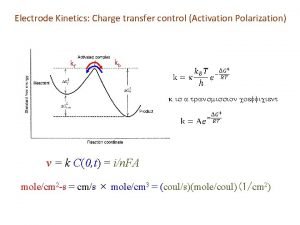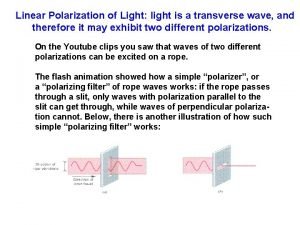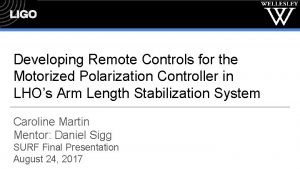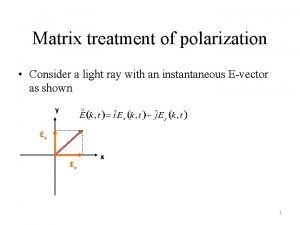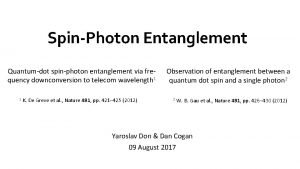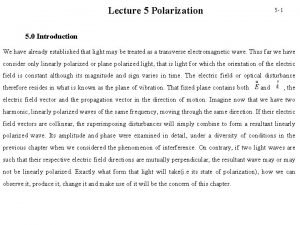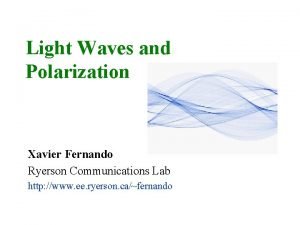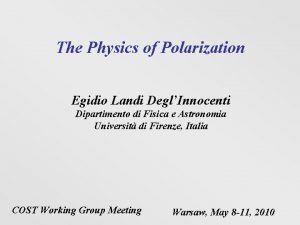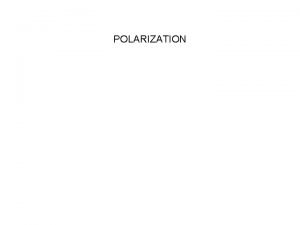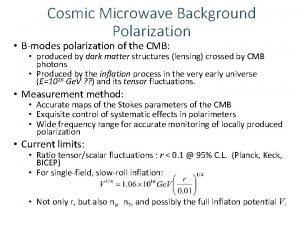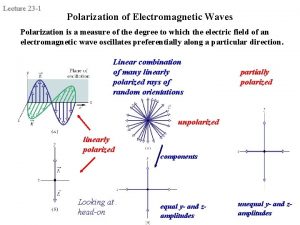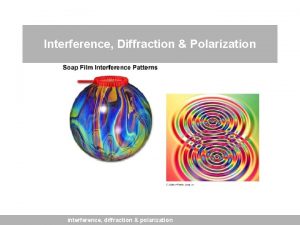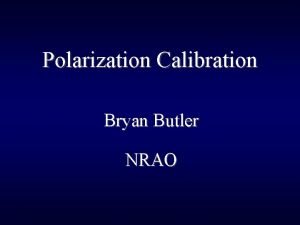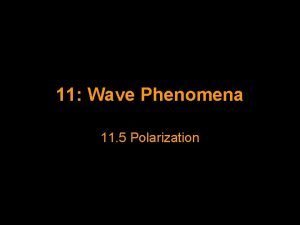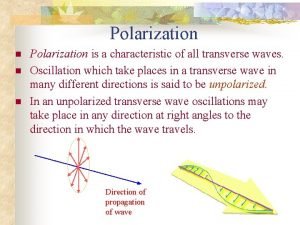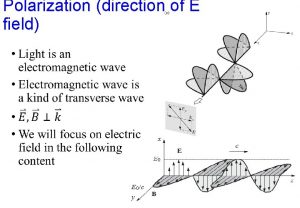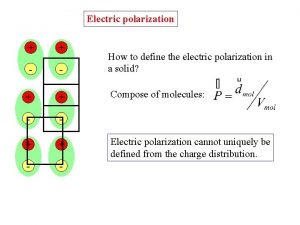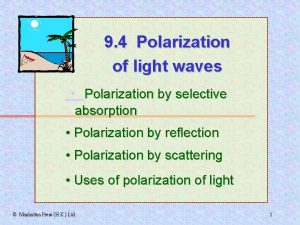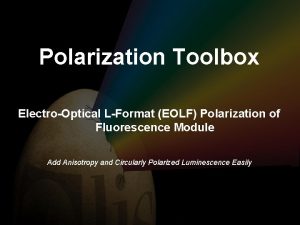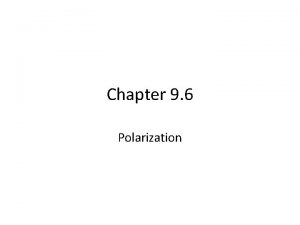The Physics of Polarization Egidio Landi DeglInnocenti Dipartimento









































- Slides: 41

The Physics of Polarization Egidio Landi Degl’Innocenti Dipartimento di Fisica e Astronomia Università di Firenze, Italia COST Working Group Meeting Warsaw, May 8 -11, 2010

Generalities Polarization = phenomenon connected with the transversality character of electromagnetic waves. In principle, polarization can be defined for any kind of transverse waves (elastic waves in a solid, seismic waves, waves in a guitar string, etc. Longitudinal waves “have no polarization”. For studying polarization, more than for any other discipline of physics, the famous words of Galileo still sound extremely approriate: “The Universe is written in mathematical language, and its characters are triangles, circles, and other geometrical figures, without which it is humanly impossible to understand a single word. ” General challenge of astronomical polarimetry: to lower the sensitivity limits of the available instruments to smaller and smaller values (10 -2, 10 -3, 10 -4, 105…. . ). It has to be remarked that this is “a never ending story”…. .

Historical Introduction I Herasmus Bartholinus (~1670) in “Experiments on double-refracting Icelandic crystals, showing amazing and unusual refraction” gives an early account of doble refraction, a phenomenon connected with polarization: it was later recognized that the two rays refracted inside an Iceland spar, a transparent variety of calcite, have different polarization properties. Christian Huyghens (~1690) in “Treatise on light” and Isaac Newton (~1730) in “Optiks” reflecting on Bartholinus’ experiment put forward, though in a qualitative way, the idea of the transversal character of light (in Newton’s words “light has sides”). Louis Malus (~1810) in “Sur une proprieté de la lumière réflechie” introduces in the lexicon of physics the word “polarization” as an intrinsic property of light. He observes that reflection on a surface changes the properties of light beams and starts producing “artificially polarized” light by means of reflections and refractions on material surfaces. He also proves the first physical law on polarization, the Malus law, or the cos 2θ law.

Historical Introduction II Augustin Fresnel (~1830) in “Mèmoires sur la réflexion de la lumière polarisée” gives the definite proof of the transversality of the “luminous oscillations”, despite the current belief that “ether is a fluid”. He also publishes the so-called Fresnel equations, still in use today, and constructs the first retarder (Fresnel prism) to produce circularly polarized light. Further important contributions are brought about by François Arago (optical activity in crystals), Jean-Baptiste Biot (optical activity in solutions, David Brewster (the Brewster angle), William Nicol (building the first polarizer), Michael Faraday (discovers the Faraday effect). George Stokes (~1852) in “On the composition and resolution of streams of polarized light from different sources” gives for the first time a fully consistent description of polarized radiation by introducing statistical arguments. He gives the operational definition of 4 real quantities (originally denoted as (I, M, C, S), today (I, Q, U, V), that are now called the Stokes parameters.

The Fresnel Equations I Fresnel equations are at the basis of a large number of physical phenomena concerning the reflection, refraction, and transmission of light at the separation surface between two media of different refractive index. In modern terms, the equations can be deduced as a boundary layer problem of Maxwell equations. They still provide the necessary tool for the construction of all the optical devices that are currently used in polarimetry.

The Fresnel Equations II The Fresnel equations can be written in several different ways. In the formalism of Muller matrices they acquire a rather compact form that imply the introduction of four independent, complex quantities, two for reflection and two for transmission. By writing I’ = M I, where I is the Stokes vector of the incident beam and I’ is the Stokes vector of the reflected (or transmitted) beam the Muller matrix M is given by

Scattering polarization One of the most important phenomena in the physics of polarization concerns the polarization properties of scattered radiation. Scattering can take place either on free electrons (Thomson scattering or Compton scattering, according to the energy of the incident photon, as compared to the rest mass of the electron), on bound electrons (Rayleigh sctattering on atoms or molecules). The physical laws controlling such properties have been initially derived from classical physics and they have been later generalized to handle relativistic and quantum effects. In classical terms, the laws of scattering polarization can be simply derived by first considering the acceleration of the electron, resulting from the electric field of the incident, polarized electromagnetic radiation beam, and by then evaluating the polarization of the radiation emitted by the accelerated electron according to the standard theory based on the Liénard & Wiechart potentials. By a similar procedure it is possible to derive theoretical polarization of bremsstrahlung, cyclotron and synchrotron radiation. In these cases the acceleration of the electron is just produced either by the collision or by the Lorentz force due to the magnetic field.

Thomson and Rayleigh Scattering I The result of classical theory for Thomson (and Rayleigh) scattering is condensed in the equations below. Note that the matrix R (defined by I = k R I’) is just a “geometrical matrix”. It simply contains the scalar products between the polarization unit vectors of the scattered and of the incident beam.

Thomson and Rayleigh Scattering II The Rayleigh scattering matrix looks rather complicated. However, it can be brought to a much simpler form by suitably selecting the geometry, like in this example, where “everything” is referred to the scattering plane.

Rayleigh Scattering III Unfortunately, when modelling astronomical objects, we are often (not to say always) confronted with very complicated geometrical scenarios. Obviously, we do not have the freedom, as usual in laboratory experiments, to set things in such a way to get what is generally called the “good geometry”. It is then very useful to introduce particular quantities that, from one side, can handle in a compact way even the most complicated geometrical situations, and, on the other hand, can keep track in the mathematical description of the relevant symmetries of the problem. In the physics (better to say in the geometry) of scattering polarization this is obtained by introducing an irreducible spherical tensor, called TKQ (Landi Degl’Innocenti: 1984, Solar Physics 91, 1) , that has revealed to be particularly suitable both in theory and applications.

Rayleigh Scattering IV The tensor is defined, in terms of rotation matrices, by the expression [R is the rotation that carries the system (e 1, e 2, Ω) in (x, y, z)]. In thse expressions the index i refers to the i-th Stokes parameter

Rayleigh Scattering V By means of this tensor the Rayleigh scattering matrix can be expressed in the form In as far as scattering in a single spectral line is concerned, and frequency redistribution problems are neglected, this expression can be easily generalized to quantum mechanics by introducing suitable “polarizabilty factors” which depend on the angular momentum quantum numbers of the particular line considered. where

Rayleigh Scattering + HANLE Effect I In the presence of a magnetic field, the Rayleigh scattering matrix is further modified by the introduction of a supplementary term where H is the magnetic field expressed in terms of the “critical field for the Hanle effect” Finally, if depolarizing collisions are also present, another factor comes into play

Rayleigh Scattering + HANLE Effect II Just for comparison: here is the matrix expressed via the tensor T KQ and here is one of the 16 matrix elements expressed through more conventional methods

Rayleigh Scattering + HANLE Effect III

Rayleigh Scattering + HANLE Effect IV The parameter γ appearing in these expressions is H of the former slide

Rayleigh Scattering in the solar corona Khan, A. , Belluzzi, L. , Landi Degl’Innocenti, E. , Fineschi, S. , Romoli, M. : 2011, Astron. & Astrophys. 529, A 12

Rayleigh Scattering in the solar corona + HANLE Effect Khan, A. , Landi Degl’Innocenti, E. : 2011, Astron. & Astrophys. 532, A 70

Rayleigh Scattering in multiplets I A further quantum-mechanical generalization concerns the laws of scattering in multiplets. The structure of the matrix R remains the same, but the “polarizability factor” WK gets transformed into a frequency dependent function The expression of the function is rather complicated. The following slides give some representative examples. It has to be remarked that the frequency dependence of the polarizability factor is brought about by the so called “quantum interference”. When a photon is scattered within the multiplet we do not know “through which upper level it is passed”. The situation is similar to the one appearing in the Young interference experiment: we do not know through which hole the photon is passed. Remarkably, these interference phenomena in multiplets have been clearly demonstrated by solar observations (Stenflo, 1980)

Rayleigh Scattering in multiplets II Multiplet n. 1 of Ca II K line H line

Rayleigh Scattering in multiplets III Multiplet UV n. 1 of Fe II

More general theoretical schemes The scattering laws previously illustrated are results that can be obtained as limiting case of a general theoretical framework that has been developed mostly for the interpretation of solar observations and for the diagnostics of solar magnetic fields in sunspots, active regions, prominences, etc. This general framework is referred to as the “Theory of the generation and transfer of polarized radiation”. It aims at giving a self-consistent description of the polarized radiation field propagating through an astrophysical plasma and of the statistical properties, in terms of populations and “coherences”, of the atoms (or molecules) composing the plasma itself. The “atomic system” is described in terms of its density matrix whereas the radiation field is described through the Stokes parameters. By standard procedures of quantum electrodynamics two sets of equations are obtained: the radiative transfer equations for polarized radition and the statistical equilibrium equations for the density matrix of the atomic system.

The Second Solar Spectrum: main test-bench for theory Second Solar Spectrum (Ivanov, 1991): linearly polarized spectrum of the solar radiation coming from quiet regions close to the limb. Reference direction A. Gandorfer, “The Second Solar Spectrum”, Vol II, 2002. Observation close to the south solar pole, 5 arcsec inside the limb.

Observational Improvements Wiehr (1975) Stenflo, Baur, & Elmore (1980) Stenflo, & Keller (1997)

Description of atomic polarization: the density matrix formalism The density operator A physical system which is in a statistical mixture of states can be convenientely described through the density operator Matrix elements of the density operator in the standard representation Diagonal elements: populations of the various magnetic sublevels Non-diagonal elements: quantum interferences (or coherences) between pairs of magnetic sublevels.

w ri te The Non-LTE problem of the 2° kind Radiative Transfer Equations so lve Collisions so lve Statistical Equilibrium Equations wr Magnetic field ite I, Q, U, V Comparison with observations

Strenghts • Equations and expressions of rates and of radiative transfer coefficients derived in a self-consistent way from the principles of quantum electrodyn. • Possibility to take into account lower level polarization • Possibility to treat multi-level atoms • Possibility to include HFS • Possibility to take into account the interaction with a magnetic field in every regime (from Zeeman to complete Paschen-Back effect regime). • Possibility to take into account both Zeeman and Hanle effects. • Possibility to describe within a self-consistent scheme “unfamiliar” quantum effects like level-crossing and anti-level-crossing. • Prediction of new polarization mechanisms like the “alignment-toorientation conversion mechanism”

Successes

Modeling of Ca II IR triplet (Manso Sainz and Trujillo Bueno 2003) Key-ingredient: lower level polarization 8542 Ǻ 3/2 - 5/2 8662 Ǻ 1/2 - 3/2 Stenflo et al. (2000) 8498 Ǻ 3/2 - 3/2 Upper level cannot carry atomic alignment (J=1/2): observed signal can be interpreted only if lower level polarization is taken into account Manso Sainz and Trujillo Bueno (2003)

Modeling of Mg I b-lines (Trujillo Bueno (1999, 2005)) Key-ingredient: lower level polarization 5167 Ǻ 1– 0 (h = 830 km) b 4 5173 Ǻ 1– 1 (h = 950 km) b 2 Stenflo, Keller, and Gandorfer (2000) 5183 Ǻ 1– 2 (h = 1010 km) b 1 If lower level polariz. is neglected, a very different amount of upper level atomic polarization is required to reproduce the profiles observed in the 3 lines (which share the same upper level, and form at similar heights!) If lower level polarization is taken into account, the observations can be reproduced by assuming the same amount of upper level polarization in the 3 lines, and a given amount of atomic polarization in the lower levels (see also Trujillo Bueno 2001).

Interpretation of spectropolarimetric observations in prominences and filaments (e. g. Trujillo Bueno et al. 2002) Key ingredients: Hanle effect, lower level polarization He I 10830 Å 10829. 09 Å: 0 – 1 10830. 25 Å: 1 – 1 10834. 40 Å: 2 – 1 Filament case (forward scattering) Observation: Positive polarization signal observed in the red components (1 – 1 and 2 – 1) Negative polarization signal observed in the blue component (0 – 1). Theoretical interpretation: Hanle effect in the presence of an inclined magnetic field. Presence of lower level polarization (anisotropic incident radiation differently absorbed by lower magnetic sublevels).

Interpretation of the second solar spectrum of Ce II (Manso Sainz et al. 2006) key ingredient: multi-level atoms Line formation model: plane parallel slab of Ce II ions illuminated from below by the continuum photspheric radiation field. Good qualitative agreement between calculated and observed polarization patterns. The lines showing the largest theoretical profiles are those which show the largest observed signals. Sign of the Q/I signal reproduced for most of the observed lines.

Interpretation of the second solar spectrum of Ti I (Manso Sainz & Landi Degl’Innocenti 2002) key ingredient: multi-level atoms Good qualitative agreement between calculated and observed polarization patterns. The lines showing the largest theoretical profiles are those which show the largest observed signals. Sign of the Q/I signal reproduced for most of the observed lines.

Differential magnetic sensitivity of Ba II 4554Å line (Belluzzi et al. 2007) Key ingredient: HFS + Hanle and Zeeman effects in the incomplete Paschen-Back effect regime Theoretical profile Q/I (%) Observed profile Wavelength (Å) Stenflo & Keller (1997) Observation close to the north solar pole, 5 arcsec inside the limb. Belluzzi et al. (2007) (see also Stenflo (1997))

Weak fields Strong fields Vertical field Horizontal field

Fit of the observations Fit of spectropolarimetric observations in the Ba II D 2 line (4554Å) performed on an active region, 9 arcsec from the limb. Date: 13/03/2007 Polarimeter: ZIMPOL (IRSOL, Locarno) (Ramelli et al. 2009)

Limitations and open problems

Unexpected failure in the interpretation of the “MS” Q/I profile of Sc II 4247 Å (Belluzzi, 2009) 2 P o 3/2 4554. 0 Å 2 S 1/2 7 isotopes 2 is. (18%) I=3/2 5 is. (82%) I=0 1 D o 2 4246. 8 Å 1 D 2 1 isotope I=7/2 Is the three peak structure of Ba II 4554 really due to HFS?

Impossibility to take into account PRD effects Intensity spectrum: PRD effects result to be important only for a limited number of very strong lines (e. g. Ca II, Mg II resonance lines, Ly-alpha), mainly in the wings. Second solar spectrum: several works, starting with the pioneering one by Dumont, Omont and Pecker (1973), pointed out that PRD effects might be the key ingredient to model the typical triplet-peak structure observed in the Q/I profile of the “champion” Ca I line at 4227 Å (the first one to be observed). We now believe that without including such effects it would not be possible to intrepret those linear polarization profiles that have been classified as “M” by Belluzzi & Landi Degl’Innocenti (2009) (e. g. Na I D 2, Ca I 4227Å, …). Indeed, without invoking PRD effects it seems impossible to explain the physical origin of such multi-peak structures.

Theoretical approaches with PRD effects Redistribution matrix for resonance scattering of polarized radiation (two-level atom with unpolarized lower level) Omont, Smith & Cooper (1972, 1973) Domke & Hubeny (1988) Heuristic approach: metalevel theory Landi Degl’Innocenti, & Landolfi (1997) Landi Degl’Innocenti (1998) Generalization of the previous theoretical approach including the higher order terms in the perturbative expansion of the atom-radiation interaction, under the hypothesis of a two-level atom with unpolarized lower term. Bommier (1997 a, 1997 b) Full generalization of the previous theoretical approach considering the next terms in the perturbative expansion of the atom-radiation interaction (i. e. inclusion of second and higher order processes). Not yet developed

Conclusions The theoretical approach based on the density matrix formalism, and self-consistently derived from the principles of quantum electrodynamics is presently one of the most solid theoretical frameworks in the field of spectropolarimetry. This theoretical approach has been highly successfull, mainly for the interpretation of signals which can be described in the limit of CRD (“S” signals). However, it suffers from the severe limitation that PRD effects cannot be accounted for. The redistribution matrix derived within the standard scattering theory of spectral line polarization is the most suitable theoretical tool for taking into account PRD effects. However, it suffers from the severe limitation of being capable of describing only two-level atoms with unpolarized lower level. The interpretation of multi-peak linear polarization profiles is today the most exciting and complex challenge for theory of polarimetry. The crucial step remains the one of succeeding to obtain a good theoretical fit of the linear polarization profile observed in the Ca I line at 4227 Å, for which the two-level atom with unpolarized lower level represents an excellent approximation.
 Polarization in physics
Polarization in physics Hans dormann
Hans dormann Landi lsi
Landi lsi Schlafsack landi
Schlafsack landi Matteo landi
Matteo landi Egidio ghilardotti
Egidio ghilardotti Ic losapio san filippo neri
Ic losapio san filippo neri Egidio ghilardotti
Egidio ghilardotti Dr diogo egidio
Dr diogo egidio Ic eduardo de filippo sant'egidio del monte albino
Ic eduardo de filippo sant'egidio del monte albino Diffraction and polarization
Diffraction and polarization Groupthink vs. group polarization
Groupthink vs. group polarization Polarization ellipse equation
Polarization ellipse equation Photon polarization
Photon polarization Dispositional attribution example
Dispositional attribution example Electric field equation
Electric field equation Depolarization factor
Depolarization factor Groupthink vs group polarization
Groupthink vs group polarization Polarization catastrophe in ferroelectrics
Polarization catastrophe in ferroelectrics Group polarization vs groupthink
Group polarization vs groupthink Electrogravimetry diagram
Electrogravimetry diagram Jones matrix polarization
Jones matrix polarization Jones vector elliptical polarization
Jones vector elliptical polarization Rainbow total internal reflection
Rainbow total internal reflection Charge polarization
Charge polarization Activation polarization
Activation polarization Linear polarization
Linear polarization Group polarization example
Group polarization example Motorized polarization controller
Motorized polarization controller Unit 14 social psychology
Unit 14 social psychology Membrane separation
Membrane separation Polarization index table
Polarization index table Group polarization example
Group polarization example Groups tend to loaf less when
Groups tend to loaf less when Jones vector elliptical polarization
Jones vector elliptical polarization Photon polarization
Photon polarization Social trap example
Social trap example Polarization in electrochemistry
Polarization in electrochemistry Light polarization equation
Light polarization equation Depolarization vs polarization
Depolarization vs polarization Xavier fernando
Xavier fernando Group polarization example
Group polarization example
